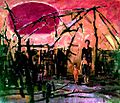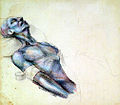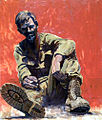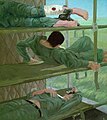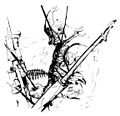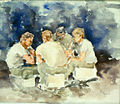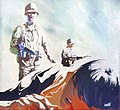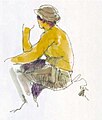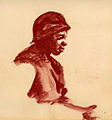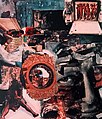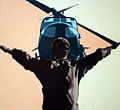
The 25th Infantry Division is a United States Army division based at Schofield Barracks in Hawaii. The division, which was activated on 1 October 1941 in Hawaii, conducts military operations primarily in the Asia-Pacific region. Its present deployment is composed of light infantry and aviation units. Tropic Lightning soldiers regularly train with other U.S. military branches to practice and maintain joint operations capabilities. The climate and terrain of the Pacific region demands Tropic Lightning soldiers be able to operate in physically demanding and harsh environments. In 2014, the division opened the Jungle Operations Training Center—the first such school in the Army since the closing of the old Jungle Warfare School at Fort Sherman, Panama Canal Zone. Joint operations and training with partner states herald a new chapter in the history of Tropic Lightning—America's Pacific Division.

The 11th Armored Cavalry Regiment is a unit of the United States Army garrisoned at the Fort Irwin National Training Center in California. The regiment has served in the Philippine–American War, the Pancho Villa Expedition, World War II, the Vietnam War, Gulf War and Iraq War. The 11th ACR serves as the opposing force (OPFOR) for the Army and Marine task forces, and foreign military forces that train at Fort Irwin.

A war artist is an artist either commissioned by a government or publication, or self-motivated, to document first-hand experience of war in any form of illustrative or depictive record. War artists explore the visual and sensory dimensions of war, often absent in written histories or other accounts of warfare.
The following outline is provided as an overview of and topical guide to the Vietnam War:
The 47th Infantry Regiment is an infantry regiment of the United States Army. Constituted in 1917 at Camp Syracuse, New York, the regiment fought in the Great War, and was later inactivated in 1921. Reactivated in 1940, the regiment fought during World War II in North Africa, Sicily, and Western Europe, then was inactivated in 1946. During the Cold War, the regiment saw multiple activations and inactivations, with service both in the Regular Army and the Army Reserve; it fought in Vietnam. Ultimately it was reactivated as a training regiment, and as of 1999, it has been assigned to Fort Moore and consists of two active battalions.

II Field Force, Vietnam was a United States Army Corps-level command during the Vietnam War.

The 27th Engineer Battalion(Combat) (Airborne)"Tiger Battalion" is an engineer battalion of the United States Army.

The 17th Cavalry Regiment is a historical organization within the United States Army that began as a regiment of cavalry after the Pancho Villa Expedition. The unit was constituted on 1 July 1916 in the Regular Army as the 17th Cavalry at Fort Bliss, Texas and originally inactivated 26 September 1921 at the Presidio of Monterey, California. Formerly a part of the 1950s Combat Arms Regimental System, it was reorganized as a part of the U.S. Army Regimental System, an ongoing effort to maintain the lineage and history of the U.S. Army through its units. Today, the 17th Cavalry Regiment is found across the army within the combat aviation brigades, where the squadrons, now constituted as attack/recon helicopter squadrons, carry on the legacy of the 17th Cavalry Regiment.

The 7th Field Artillery Regiment is a United States Army field artillery regiment, whose lineage traces back to the early 20th century.

A civic action program also known as civic action project is a type of operation designed to assist an area by using the capabilities and resources of a military force or civilian organization to conduct long-term programs or short-term projects. This type of operations include: dental civic action program (DENTCAP), engineering civic action program (ENCAP), medical civic action program (MEDCAP), and veterinarian civic action program (VETCAP). Entities of foreign nations usually conduct these operations at the invitation of a host nation.
The United States Army Art Program or U.S. Army Combat Art Program is a U.S. Army program to create artwork documenting its involvements in war and peacetime engagements. The art collection associated with the program is held by the U.S. Army Center of Military History. The United States Army Centre of Military History built the National Museum of the United States Army at Fort Belvoir that is now completed and will open when conditions allow.
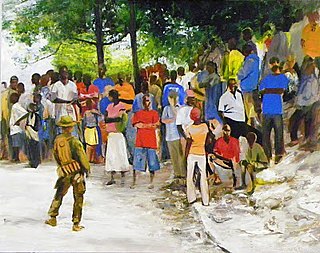
American official war artists have been part of the American military since 1917. Artists are unlike the objective camera lens which records only a single instant and no more. The war artist captures instantaneous action and conflates earlier moments of the same scene within one compelling image.
"We're not here to do poster art or recruiting posters... What we are sent to do is to go to the experience, see what is really there and document it—as artists."
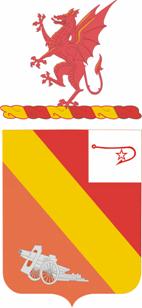
The 13th Field Artillery Regiment is a field artillery regiment of the United States Army first formed in 1916.

The 15th Field Artillery Regiment (FAR) is a field artillery regiment of the United States Army first formed in 1916. A parent regiment under the U.S. Army Regimental System, the 15th FAR currently has two active battalions: the 1st Battalion, 15th Field Artillery Regiment, is assigned to the 1st Brigade Combat Team, 2nd Infantry Division, while the 2nd Battalion, 15th Field Artillery Regiment, is assigned to the 2nd Brigade Combat Team, 10th Mountain Division.
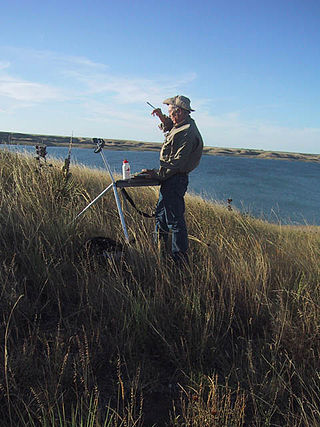
James Pollock is an American artist living in Pierre, South Dakota. Pollock has been characterized as a painter whose work is a bridge between the abstract and the concrete. His style varies widely, sometimes drawing on the abstract styles reminiscent of artists of the early 20th-century Bauhaus school, characterized by strong lines and bold colors, sometimes resembling ancient cave paintings, and sometimes straightforward renderings of landscapes and objects." Pollock is an active plein air painter and member of the South Dakota Plein Air Artists movement.

The 25th Aviation Regiment is an aviation regiment of the U.S. Army.
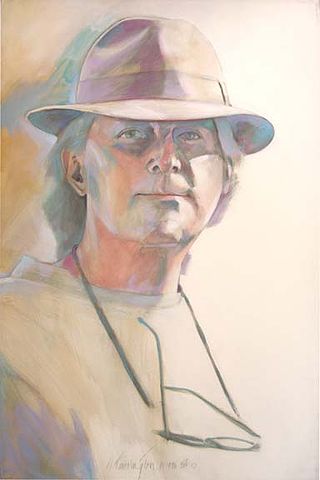
David Fairrington is an American artist. Mostly associated with his realistic portraits, Fairrington paints a variety of subjects including landscapes, still life, and western art in a range of styles including abstract, conceptual, fantasy, figurative, impressionist, pop art and romantic. He attributes artist John Singer Sargent and famed illustrator Norman Rockwell as significant influences in his work.
Company E, 52nd Infantry, (LRP) was a 120 man-sized long-range reconnaissance patrol unit attached to the 1st Cavalry Division (Airmobile) in Vietnam in 1967-69. Its origin begins on January 1, 1967, as "LRRP Detachment G2," 1st Cavalry Division (Airmobile). It was then redesignated "Headquarters & Headquarters Company LRRP Detachment" in April 1967, and redesignated "Company E, 52nd Infantry (LRP)" on December 20, 1967.
The battalion is currently part of the U.S. Army Engineer School, headquartered at Fort Leonard Wood, Missouri and is a subordinate unit to the 1st Engineer Brigade. The battalion mainly conducts advanced individual training for engineering vertical skills and specialty engineering skills.

210th Aviation Regiment is aviation regiment of the United States Army.



